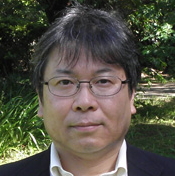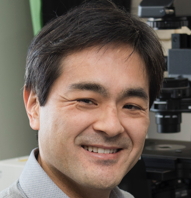Research - A01:Selected Projects (FY2020-FY2021) -
Click here for research plans of Selected Research Projects (2018-2019).
A01:Selected Research Projects (FY2020-FY2021)
De novo formation and conversion of meristematic stem cell niches during shoot regeneration and their regulatory mechanisms
| PI | Munetaka Sugiyama | Graduate School of Science, The University of Tokyo |  |
Plant organ regeneration is a dynamic process involving de novo formation and conversion of meristematic stem cell niches. In the two-step shoot regeneration system of Arabidopsis thaliana, where callus is induced by high concentrations of auxin and then adventitious buds are induced by high concentrations of cytokinin, root apical meristem-type stem cell niche first arise and subsequently change into shoot apical meristem-type niches, leading to the establishment of adventitious buds. In the present research, we investigate the molecular network underlying this process with a focus on the roles of endogenous IAA and the TBP-associated factor BTAF1, together with comparative analysis of non-callus-mediated, direct shoot regeneration of Torenia fournieri, for the purpose of elucidating behaviors and regulatory mechanisms of stem cells during shoot regeneration.
Stem cell maintenance during axillary meristem formation
| PI | Wakana Tanaka | Graduate School of Integrated Sciences for Life, Hiroshima University |  |
Various organs such as branches and floral organs are derived from stem cells present in the axillary meristem (axillary stem cells), which is continuously established throughout plant life. Although our knowledge of the mechanisms underlying the establishment and maintenance of stem cells in the shoot apical meristems has accumulated in several plants such as Arabidopsis, maize and rice, our understanding of these mechanisms during axillary meristem formation is still insufficient.
In this study, we aim to elucidate the molecular mechanisms underlying the maintenance of stem cell homeostasis during axillary meristem formation in rice (Oryza sativa). We plan to analyze the function of genes associated with FON2-TAB1 pathway, which is indispensable for the maintenance of axillary stem cells during vegetative branch formation. We also plan to analyze mutants that show abnormal flower morphology to clarify a role of stem cell maintenance in flower development.
Novel mechanisms for maintenance of shoot stem cells and acquisition of pluripotency
| PI | Naoyuki Uchida | Center for Gene Research, Nagoya University |  |
In this project, our group investigates two aspects of shoot stem cells; maintenance and pluripotency. Recently our group discovered a novel mechanism for the maintenance of stem cells in the shoot apical meristem. This mechanism can maintain stem cells even without an important factor which has been regarded essential for these 30 years in the Arabidopsis research history. We aim to identify new factors acting in this mechanism. We also study a small molecule that induces the formation of cell mass from root tissues, which harbors pluripotency for shoot regeneration. We aim to reveal a hidden potential for the acquisition of pluripotency, which has been uncovered by conventional genetic approaches.
Stem cell formation by establishment of low auxin responsiveness
| PI | Ryuichi Nishihama | Graduate School of Biostudies, Kyoto University |  |
Stem cell formation during embryogenesis in angiosperms involves the phytohormone auxin. However, the mechanistic link between auxin responsiveness regulation and stem cell formation has not been fully clarified. Our research using a basal land plant, the liverwort Marchantia polymorpha, suggested a strong correlation between low auxin responsiveness and stem cell-ness. In this project, by making full use of powerful genetics of M. polymorpha, we will elucidate its underlying molecular mechanisms, as well as gene regulatory networks in which various signaling pathways for stem cells, such as peptide ligand-mediate cell-cell communication pathways, influence auxin responsiveness. From the aspect of ‘low auxin responsiveness’, we aim to characterize plant stem cells.
Establishment of phytohormone microenvironment during shoot stem cell formation
| PI | Mitsuhiro Aida | International Research Organization for Advanced Science and Technology, Kumamoto University |  |
Shoot stem cells are initially established during embryogenesis in a boundary region between cotyledons and are maintained throughout the plant life. Although it is known that a microenvironment consisting of two phytohormones, auxin and cytokinin, is particularly important for stem cell maintenance in the shoot, how this environment is established during embryogenesis remains elusive. By focusing on a set of transcription factors, CUC1, CUC2 and CUC3, which are central regulators for boundary specification in Arabidopsis, we will investigate their roles in the establishment of the phytohormone microenvironment and clarify their significance in the shoot stem cell regulation.
Molecular mechanisms underlying histone modification changes for stem cell formation induced by wounding
| PI | Masaki Ishikawa | National Institute for Basic Biology |  |
Epigenetic modifications, including histone modifications, function in stabilization of cell-specific gene expression programs to maintain cell identities in both metazoans and land plants. On the other hand, land plants have a high intrinsic ability to reprogram differentiated cells to stem cells in response to wounding. However, it remains to be elucidated how wounding induces the erasure of somatic epigenetic patterns for stem cell formation. In the moss Physcomitrella patens, ectopic induction of STEMIN1 transcription factor in gametophores directly changes gametophore leaf cells to chloronema apical stem cells with local histone modification changes. In addition, the STEMIN1 gene expression is dramatically induced by wounding. These indicate that STEMIN1 is a key factor linking between wounding and the erasure of somatic epigenetic patterns. In this study, we aim to investigate transcriptional regulation of STEMIN1 gene by wounding and to understand molecular mechanisms controlling the histone modification changes by the STEMIN1 induction.
Molecular mechanisms underlying stem cell reformation in wound callus
| PI | Akira Iwase | RIKEN Center for Sustainable Resource Science |  |
Plants form cell masses called callus at the site of injury and regenerate stem cells within the callus to regenerate tissue, but the cellular lineage and molecular processes involved in this process are poorly understood. My previous work has produced Arabidopsis plants that regenerate roots and stems from wound callus, even in exogenous phytohormone-free media. In this study, I will use this system to elucidate the molecular mechanisms how wound callus cells change into root and shoot stem cells. We will provide a comprehensive view of gene expression changes such as regeneration markers and epigenetics-related factors in individual cells temporally, and use biochemical and genetic methods to elucidate gene networks, hormone response changes, and epigenomic changes required for stem cell reformation in the wound callus.
A homeobox-mediated suppression mechanism to restrict stem cell initiation during organ regeneration
| PI | Momoko Ikeuchi | Faculty of Science, Niigata University |  |
Regenerative capacity largely varies among plant species, yet intrinsic mechanisms to restrict organ regeneration remain elusive. We have identified a homeobox transcription factor that negatively impacts shoot regeneration efficiency in tissue culture system. Microscopic analyses indicate that this factor affects the proportion of callus cells that undergo stem cell initiation. Here in this project, I will compare cellular composition of calli in wild-type and the homeobox mutant by single cell RNA-seq analysis. We will also analyze molecular function of this key homeobox transcription factor in suppressing stem cell initiation. These analyses together will reveal novel regulatory mechanism of stem cell initiation.
